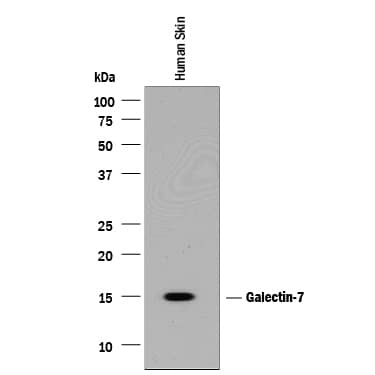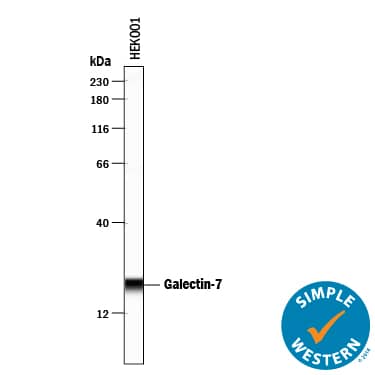Human Galectin-7 Antibody
R&D Systems, part of Bio-Techne | Catalog # AF1339


Key Product Details
Species Reactivity
Validated:
Cited:
Applications
Validated:
Cited:
Label
Antibody Source
Product Specifications
Immunogen
Ser2-Phe136
Accession # NP_002298
Specificity
Clonality
Host
Isotype
Scientific Data Images for Human Galectin-7 Antibody
Detection of Human Galectin‑7 by Western Blot.
Western blot shows lysates of human skin tissue. PVDF membrane was probed with 1 µg/mL of Goat Anti-Human Galectin-7 Antigen Affinity-purified Polyclonal Antibody (Catalog # AF1339) followed by HRP-conjugated Anti-Goat IgG Secondary Antibody (Catalog # HAF017). A specific band was detected for Galectin-7 at approximately 15 kDa (as indicated). This experiment was conducted under reducing conditions and using Immunoblot Buffer Group 1.Detection of Human Galectin‑7 by Simple WesternTM.
Simple Western lane view shows lysates of HEK001 human epidermal keratinocyte cell line, loaded at 0.2 mg/mL. A specific band was detected for Galectin-7 at approximately 21 kDa (as indicated) using 10 µg/mL of Goat Anti-Human Galectin-7 Antigen Affinity-purified Polyclonal Antibody (Catalog # AF1339) followed by 1:50 dilution of HRP-conjugated Anti-Goat IgG Secondary Antibody (Catalog # HAF109). This experiment was conducted under reducing conditions and using the 12-230 kDa separation system.Applications for Human Galectin-7 Antibody
Immunohistochemistry
Sample: Immersion fixed paraffin-embedded sections of human skin
Simple Western
Sample: HEK001 human epidermal keratinocyte cell line
Western Blot
Sample: Human skin tissue
Human Galectin-7 Sandwich Immunoassay
Reviewed Applications
Read 4 reviews rated 4.3 using AF1339 in the following applications:
Formulation, Preparation, and Storage
Purification
Reconstitution
Formulation
Shipping
Stability & Storage
- 12 months from date of receipt, -20 to -70 °C as supplied.
- 1 month, 2 to 8 °C under sterile conditions after reconstitution.
- 6 months, -20 to -70 °C under sterile conditions after reconstitution.
Background: Galectin-7
The galectins constitute a large family of carbohydrate-binding proteins with specificity for N-acetyl-lactosamine-containing glycoproteins. At least 14 mammalian galectins, which share structural similarities in their carbohydrate recognition domains (CRD), have been identified. The galectins have been classified into the prototype galectins (-1, -2, -5, -7, -10, -11, -13, -14), which contain one CRD and exist either as a monomer or a noncovalent homodimer; the chimera galectins (Galectin-3) containing one CRD linked to a nonlectin domain; and the tandem-repeat galectins (-4, -6, -8, -9, -12) consisting of two CRDs joined by a linker peptide. Galectins lack a classical signal peptide and can be localized to the cytosolic compartments where they have intracellular functions. However, via one or more as yet unidentified non-classical secretory pathways, galectins can also be secreted to function extracellularly. Individual members of the galectin family have different tissue distribution profiles and exhibit subtle differences in their carbohydrate-binding specificities. Each family member may preferentially bind to a unique subset of cell-surface glycoproteins (1-4). Human Galectin-7 is a prototype monomeric galectin. It is specifically expressed in stratified epithelia, notably in epidermis, but is barely detectable in epidermal tumors and significantly down regulated or absent from squamous carconima cell lines. The Galectin-7 gene is induced by tumor suppressor protein p53 transcriptional activity following genotoxic events. A pro-apoptotic protein, Galectin-7 functions intracellularly upstream of JNK activation and cytochrome-c release. This protein has been shown to increase the susceptibility of keratinocytes to UVB induced apoptosis, an essential processss in the maintenance of epidermal homeostasis. Cell lines transfected with the Galectin-7 gene localized the protein in the nucleus and intracellularly. Human and mouse Galectin-7 share 79% amino acid homology (4-6).
References
- Rabinovich, A. et al. (2002) TRENDS in Immunol. 23:313.
- Rabinovich, A. et al. (2002) J. Leukocyte Biology 71:741.
- Hughes, R.C. (2002) Biochimie 83:667.
- R&D Systems Cytokine Bulletin; Summer 2002.
- Bernerd, F. et al. (1999) Proc. Natl. Acad. Sci. USA 96:11329.
- Kuwabara, I. et al. (2002) J. Biol. Chem. 277:3487.
Alternate Names
Gene Symbol
UniProt
Additional Galectin-7 Products
Product Documents for Human Galectin-7 Antibody
Product Specific Notices for Human Galectin-7 Antibody
For research use only
